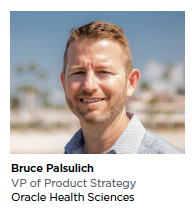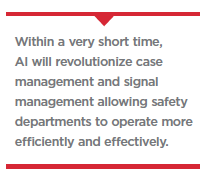 Advanced Technology Helps Protect Patients and Billions in R&D Investment.
Advanced Technology Helps Protect Patients and Billions in R&D Investment.
Bringing a new medicine, medical device, vaccine, or combination product to market today requires enormous investment. PhRMA estimates that a new drug takes nearly a decade to make it from discovery to approval and an overall investment of more than $2.6 billion. During that journey from clinical trials through post-marketing surveillance, safety risk monitoring is an integral part of the process.
Pharmacovigilance is first and foremost, vital to patient safety, in addition to being a regulatory requirement. But pharmacovigilance also protects organizations from potential financial and reputational costs associated with recall, fines, or negative media coverage. It has also grown far more challenging in recent years, in an environment of more complex products, ever-changing regulations, and — crucially — a surge in the volume of safety data that must be gathered and analyzed. This is placing steeply increasing demands on safety departments, as companies look to hold the line on costs.
So how do safety teams overcome this data challenge? One way is through the use of artificial intelligence (AI). AI has the potential to replace the majority of traditionally manual processes with automated ones that can rapidly sift through and prioritize this huge volume of information. In the process, AI can give time back to safety organizations that are under massive pressure to more effectively deal with the substantive safety data.
Facing an Overload
Both safety case management and safety signal management are facing data deluges today. The number of incoming adverse event cases has increased significantly in recent years due to a combination of new regulations, patient support programs, and consumer reporting channels. For some safety organizations or departments, this has driven an annual increase in caseload of as much as 50%. Yet, there’s an incredible level of “noise" in that data stream that includes cases that don’t actually add any new information to a product’s safety profile, nonetheless they must be reviewed or processed.
Not surprisingly, signal management has been strained by data bloat. Where it once relied on mining databases of spontaneous reactions, there is now an array of additional data sources that must be considered. Clinical trial data, electronic health records, administrative claims, social media, and many other sources all add  to the information store and could lead to new safety insights. Along with this influx of new data comes uncertainty about how to analyze it properly and sufficiently while not overwhelming already-strapped safety organizations.
to the information store and could lead to new safety insights. Along with this influx of new data comes uncertainty about how to analyze it properly and sufficiently while not overwhelming already-strapped safety organizations.
Given the increased workload, companies are finding it almost impossible to sustain their historic manual safety signal review processes. Not only is the cost enormous, but there are also too few human experts to perform the manual review with this exponentially increased set of data.
Automating the Process with AI
AI leverages Big Data and replaces manual workflows with algorithms.
Processing large amounts of data at high speed, AI can identify cases and signals that merit additional analysis by expert resources. This removes the “noise," reducing the effective workload for staff and allowing them to concentrate their valuable time on the most important cases and signals.
AI is fundamentally different from the robotic process automation tools that have been available for years in that it is not replacing the physical processes, but rather, the mental processes. In addition, the deep learning algorithms of AI — machine learning — improve the technology’s ability over time, so the system is constantly delivering more value. Also, natural language processing techniques can extract adverse event information from unstructured free-text narratives, circumventing the drawn-out time needed for manual data entry.
It’s important to understand that there’s no general AI tool that can simply be pointed towards a safety problem and be expected to produce accurate results.
Dozens of highly specialized algorithms, based on insight from deep domain experts and people in the trenches of safety case management, work together are what create a solid safety solution. This is why Oracle Health Sciences has brought experts in both areas — AI and Safety — into our product management and development teams to conduct and publish basic research in the field and guide our AI in safety innovation.
Within a very short time, AI will revolutionize case management and signal management allowing safety departments to operate more efficiently and effectively. This new data and AI revolution will both protect patients and the companies working every day to develop new ways to improve health and quality of life for patients waiting in need.(PV)
Oracle Health Sciences offers customers the industry’s most advanced cloud solution for clinical trial planning, data collection, trial execution, and safety management.
For more information, visit oracle.com.
















